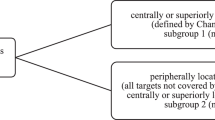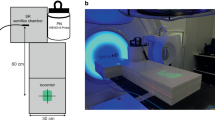Abstract
Purpose
To evaluate the feasibility of flattening filter free beam (FFFB) for the treatment of gastric tumors and to review their benefits over 6MV flatten beam (6MV_FFB).
Methods
Fifteen patients with histologically proven gastric carcinoma were selected. CT scans with slice thickness of 0.3 cm were acquired and planning target volume (PTV) and organ at risk (OAR) were delineated. Plans were made retrospectively for each patient for the prescription dose of 45 Gy/25 fractions to the PTV. Four isocentric plans were compared in the present study on Varian TrueBeam linear accelerator (Varian Medical Systems, Palo Alto, CA, USA).
Results
PTV D98% was 44.41 ± 0.12, 44.38 ± 0.13, 44.59 ± 0.14, and 44.49 ± 0.19 Gy for IMRT 6MV_FFB, IMRT 6MV_FFFB, VMAT 6MV_FFB, and VMAT 6MV_FFFB respectively. 6MV_FFFB beam minimizes the mean heart dose Dmean (P = 0.001). VMAT dominates over IMRT when it came to kidney doses V12Gy (P = 0.02), V23Gy (P = 0.015), V28Gy (P = 0.011), and Dmax (P < 0.01). VMAT has significantly reduced the doses to kidneys. It was analyzed that 6MV_FFFB significantly reduces the dose to normal tissues (P = 0.006 and P = 0.018). VMAT significantly reduces the TMU, which is required to deliver the similar dose by IMRT (P < 0.01).
Conclusions
Unflattened beam spares the organs at risk significantly to avoid the chances of secondary malignancies and reduces the intra-fraction motion during treatment due to provision of higher dose rate. Hence, we conclude that 6MV unflattened beam can be used to treat gastric carcinoma.




Similar content being viewed by others
References
Massimo Rugge, Matteo Fassan, David Y.Graham; Epidemiology of gastric cancer. Gastric Cancer pp 23–34.
Guggenheim DE, Shah MA. Gastric cancer epidemiology and risk factors. J Surg Oncol. 2013;107(3):230–6.
Leong T, Willis D, Joon DL, Condron S, Hui A, Ngan SY. 3D conformal radiotherapy for gastric cancer—results of a comparative planning study. Radiother Oncol. 2005 Mar;74(3):301–6.
Blot WJ, Devesa SS, Kneller RW, Fraumeni JF Jr. Rising incidence of adenocarcinoma of the esophagus and gastric cardia. JAMA. 1991;265:1287–9.
Powell J, McConkey CC. The rising trend in oesophageal adenocarcinoma and gastric cardia. Eur J Cancer Prev. 1992;1:265–9.
Botterweck AA, Schouten LJ, Volovics A, et al. Trends in incidence of adenocarcinoma of the oesophagus and gastric cardia in ten European countries. Int J Epidemiol. 2000;29:645–54.
Okabayashi T, Gotoda T, Kondo H, Inui T, Ono H, Saito D, et al. Early carcinoma of the gastric cardia in Japan: is it different from that in the West? Cancer. 2000;89:2555–9.
Chung JW, Lee GH, Choi KS, et al. Unchanging trend of esophagogastric junction adenocarcinoma in Korea: experience at a single institution based on Siewert’s classification. Dis Esophagus. 2009;22:676–81.
Naseri A, Mesbahi A. A review on photoneutrons characteristics in radiation therapy with high energy photon beams. Rep Pract Oncol Radiother. 2010 Sep;15(5):138–44.
Otto K. Volumetric modulated arc therapy: IMRT in a single gantry arc. Med Phys. Jan 2008;35(1):310–7.
Teh BS, Woo SY, Brian Butler E. Intensity modulated radiation therapy (IMRT): a new promising technology in radiation oncology. Oncologist. 1999;4:433–42.
Lorraine Portelance KS, Chao C, Grigsby PW, Bennet H, Low D. Intensity-modulated radiation therapy (IMRT) reduces small bowel, rectum and bladder doses in patients with cervical cancer receiving pelvic and para-aortic irradiation. Int J Radiat Oncol Biol Phys. 2001;51(1):261–6.
Ringash J, Perkins G, Brierley J, et al. IMRT for adjuvant radiation in gastric cancer: a preferred plan? Int J Radiat Oncol Biol Phys. 2005;63(3):732–8.
Nicolini G, Sarbani GL, Shrivastava SK, et al. Filter-free beams compared with static gantry IMRT and 3D conformal radiotherapy for advanced esophageal cancer: a feasibility study. Int J Radiat Oncol Biol Phys. 2012;84(2):553–60.
Kumar L, Yadav G, KR Samuvel MB, Kumar P, Suhail M, Pal M. Dosimetric influence of filtered and flattening filter free photon beam on rapid arc (RA) radiotherapy planning in case of cervix carcinoma. Rep Pract Oncol Radiother. 2017;22:10–8.
Dang TM, Peters MJ, Hickey B, Semciw A. Efficacy of flattening filter free beam in stereotactic body radiation therapy planning and treatment: a systematic review with meta-analysis. J Med Imaging Radiat Oncol. 2017;61:379–87.
Stephen RS, Jacqueline KB, Daniel GH, et al. Updated analysis of SWOG-directed intergroup study 0116: a phase III trial of adjuvant radiochemotherapy versus observation after curative gastric cancer resection. J Clin Oncol. 2012;30(19):2327–33.
Contouring Atlases- RTOG available on https://www.rtog.org/CoreLab/ContouringAtlases.aspx
John SM, Stephen RS, Jacqueline B, et al. Chemoradiotherapy after surgery compared with surgery alone for adenocarcinoma of the stomach or gastroesophageal junction. N Engl J Med. 2001;345:725–30.
Marks LB, Yorke ED, Jackson A, et al. The use of normal tissue complication probability (NTCP) models in the clinic. Int J Radiat Oncol Biol Phys. 2010;76(3):S10–9.
Zhai DY, Yin Y, Gong GZ, Liu TH, Chen JH, Ma CS, et al. RapidArc radiotherapy for whole pelvis lymph node in cervical cancer with 6 and 15 MV: a treatment planning comparison with fixed field IMRT. J Radiat Res. 2012;00:1–8.
ICRU Report 83. Prescribing, recording and reporting intensity modulated radiation therapy. Bethesda: International Commission on Radiation Units and Measurements; 2010.
D’Arienzo M, Stefano GM, deSanctis V, Mattia FO, Chiacchiararelli L, Riccardo ME. Integral dose and radiation-induced secondary malignancies: comparison between stereotactic body radiation therapy and three- dimensional radiotherapy. Int J Environ Res Public Health. 2012;9(11):4223–40.
Lin MH, Veltchev I, Koren S, Ma C, Li J. Robotic radio-surgery system patient specific QA for extra-cranial treatments using the planer ion chamber array and the cylindrical diode array. JACMP. 2015;16(4):290–305.
Hussein M, Rowshanfarzad P, Ebert MA, Nisbet A, Clark CH. A comparison of the gamma index analysis in various commercial IMRT/VMAT QA systems. Radiother Oncol. 2013 Dec;109(3):370–6.
Zwahlen DR, Lang S, Hrbacek J, Glanzmann C, Kloeck S, Najafi Y, et al. The use of photon beams of a flattening filter-free linear accelerator for hypofractionated volumetric modulated arc therapy in localized prostate cancer. Int J Radiat Oncol Biol Phys. 2012;83:1655–60.
Hrbacek J, Lang S, Graydon SN, Klöck S, Riesterer O. Dosimetric comparison of flattened and unflattened beams for stereotactic ablative radiotherapy of stage I non-small cell lung cancer. Med Phys. 2014;41:031709.
Garis D, Ohlhues L, Brodin NP, et al. A treatment planning and delivery comparison of volumetric modulated arc therapy with or without flattening filter for gliomas, brain metastases, prostate, head/neck and early stage lung cancer. Acta Oncol. 2014;53:1005–11.
Deng X, Han C, Chen S, et al. Dosimetric benefits of intensity-modulated radiotherapy and volumetric modulated arc therapy in the treatment of post-operative cervical cancer patients. J Appl Clin Med Phys. 2017;18(1):25–31.
Cozzi L, Dinshaw KA, Shrivastava SK, Mahantshetty U, Engineer R, Deshpande DD, et al. A treatment planning study comparing volumetric arc modulation with RapidArc and fixed field IMRT for cervix uteri radiotherapy. Radiother Oncol. 2008;89:180–91.
Sharma MK, Mitra S, Saxena U, Bhushan M, Shrivastava H, Simson DK, et al. Is volumetric modulated arc therapy (RapidArc) better than intensity modulated radiotherapy for gynecological malignancies? A dosimetric comparison. J Cancer Res Ther. 2014;10:883–8.
Yadav G, Bhushan M, Dewan A, Saxena U, Kumar L, Chauhan D, et al. Dosimetric influence of photon beam energy and number of arcs on volumetric modulated arc therapy in carcinoma cervix: a planning study. Rep Pract Oncol Radiother. 2017;22:1–9.
Vassiliev ON, Kry SF, Kuban DA, et al. Treatment planning study of prostate cancer intensity-modulated radiotherapy with a Varian Clinac operated without a flattening filter. Int J Radiat Oncol Biol Phys. 2007;68(5):1567–71.
Daniel RZ, Stephanie L, Jan H, Christoph G, Stephan K, Yousef N, et al. The use of photon beams of a flattening filter-free linear accelerator for hypofractionated volumetric modulated arc therapy in localized prostate cancer. Int J Radiat Oncol Biol Phys. 2012;83(5):1655–60.
Fu W, Dai J, Hu Y, Han D, Song Y. Delivery time comparison for intensity-modulated radiation therapy with/without flattening filter: a planning study. Phys Med Biol. 2004;49:1535–47.
Hall EJ, Wuu CS. Radiation-induced second cancers: the impact of 3DCRT and IMRT. Int J Radiat Oncol Biol Phys. 2003;56:83–8.
Gulliford SL, Foo K, Morgan RC, et al. Dose-volume constraints to reduce rectal side effects from prostate radiotherapy: evidence from MRC RT01 Trail ISRCTN 47772397. Int J Radiat Oncol Biol Phys. 2010;76(3):747–54.
Vassiliev ON, Kry SF, Chang JY, et al. Stereotactic radiotherapy for lung cancer using a flattening filter free clinic. J Appl Clin Med Phys. 2009;10:2880.
Kry SF, Vassiliev ON, Mohan R. Out-of-field photon dose following removal of the flattening filter from a medical accelerator. Phys Med Biol. 2010;55:2155–66.
Murray LJ, Thompson CM, Lilley J, Cosgrove V, Franks K, Sebag-Montefiore D, et al. Radiation-induced second primary cancer risks from modern external beam radiotherapy for early prostate cancer: impact of stereotactic ablative radiotherapy (SABR), volumetric modulated arc therapy (VMAT) and flattening filter free (FFF) radiotherapy. Phys Med Biol. 2015;60:1237–57.
Kragl G, Baier F, Lutz S, Albrich D, Dalaryd M, Kroupa B, et al. Flattening filter free beams in SBRT and IMRT: dosimetric assessment of peripheral doses. Z Med Phys. 2011;21:91–101.
Cashmore J, Ramtohul M, Ford D. Lowering whole-body radiation doses in pediatric intensity-modulated radiotherapy through the use of unflattened photon beams. Int J Radiat Oncol Biol Phys. 2011;80:1220–7.
Vassiliev ON, Titt U, Ponisch F, et al. Dosimetric properties of photon beams from a flattening filter free clinical accelerator. Phys Med Biol. 2006;51:1907–17.
Kamangar F, Dores GM, Anderson WF. Patterns of cancer incidence, mortality and prevalence across five continents: defining priorities to reduce cancer disparities in different geographic regions of the world. J Clin Oncol. 2006;24:2137–50.
McClosky SA, Yang GY. Benefits and challenges of radiation therapy in gastric cancer: techniques for improving outcomes. Gastrointest Cancer Res. 2009;3(1):15–9.
Jemal A, Bray F, Center MM, et al. Global cancer statistics. CA Cancer J Clin. 2011;61:69–90.
Spruijt KH, Dahele M, Cuijpers JP, Jeulink M, Rietveld D, Slotman BJ, et al. Flattening filter free vs flattened beams for breast irradiation. Int J Radiat Oncol Biol Phys. 2013;85:506–13.
Hoffmann L, et al. Implementation and experimental validation of the high dose rate stereotactic treatment mode at Varian accelerators. Acta Oncol. 2009;48:201–8.
Author information
Authors and Affiliations
Corresponding author
Ethics declarations
Conflict of Interest
The authors declare that they have no conflict of interest.
Rights and permissions
About this article
Cite this article
Bhushan, M., Yadav, G., Tripathi, D. et al. Dosimetric Analysis of Unflattened (FFFB) and Flattened (FB) Photon Beam Energy for Gastric Cancers Using IMRT and VMAT—a Comparative Study. J Gastrointest Canc 50, 408–419 (2019). https://doi.org/10.1007/s12029-018-0080-9
Published:
Issue Date:
DOI: https://doi.org/10.1007/s12029-018-0080-9




